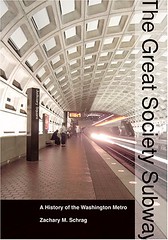Do transit system shortcuts doom transit success?

The argument that Zach Scrag makes in his newly published historical study of the Washington subway system, The Great Society Subway : A History of the Washington Metro, is that the project reflects the values of "The Great Society," that government could make life better for the nation's citizens, and that government is capable of accomplishing great things, such as major construction projects on the scale of the Washington Metropolitan Area Transit Authority.
I haven't had a chance to delve into the book yet, so I can't say how much I will buy into his argument... I had a side conversation with a planner a couple days later at another presentation (not about the subway) and he questioned the thesis, stating something to the nature of "well stations like Fort Totten are butt ugly so how could you argue that the Great Society value of beauty was truly operationalized into the actual creation on the ground of Washington's subway system." (Note this is my rendition of his argument...)
_______
For a WAMU-FM interview with Zach Schrag, about "Washington Metro at Thirty," from today, March 23, 2006, available in the archives or transcript, click here.
________
I raise this because of the value engineering that's going on wrt the design of the Tysons Corner-Dulles Airport extension of the subway system. According to an article in today's Post, "Dulles Rail Project Faces Cuts as Costs Swell," they are looking at serious "amenities" cuts in order to keep the cost of the system around $2 billion dollars. From the article:
The contractors on the project to extend Metrorail to Dulles International Airport are proposing to slash several key features -- including the number of rail cars and pedestrian bridges for those boarding in Tysons Corner -- to rein in a new spike in costs, a project director said yesterday...
But with time running out before the project's plans need to go to the federal government in May, and with the new estimates bumping up against the $2 billion limit, he said, the many players involved in the rail extension need to make some tough calls or risk seeing the project run off course....
Metro will probably fight the proposal to cut 20 train cars from the 64 that had been proposed for the line, saving $62 million. Patty Nicoson, president of the Dulles Corridor Rail Association, a nonprofit group organized by the project's boosters, said she hopes that the pedestrian bridges and other features, if dropped, could be restored later by developers seeking to build near the rail line. The most important thing, she said, is that the partners on the project settle on the needed cuts quickly and move the project along.
"They're going to have to roll up their shirtsleeves and decide what's really important to keep in or address at a later date," she said. "We should go with a skeleton system now and add to it in the future. That's not ideal, but it's realistic."
I really wonder if at the outset, they are dooming the possibility of success for the extension? People talk about incremental improvements, getting the system in the ground, but usually improvements aren't put back in.
 Illustration of the guideway on Route 7 at Spring Hill Road, 27 feet above street level. Photo Credit: Dulles Corridor Metro Project.
Illustration of the guideway on Route 7 at Spring Hill Road, 27 feet above street level. Photo Credit: Dulles Corridor Metro Project.And my sense is the belief "that we just need to get the system in place, started" is short-sighted because people make initial judgements based on what they see, and if they aren't impressed, it's hard to get them to change their opinions. (Note to Main Street commercial district revitalization programs, this is why I recommend waiting and putting up a great website or creating great brochures, rather than putting up basic unimpressive efforts. Even without thinking about it, people compare such efforts to the much more professional information that they view every day, ranging from their local newspaper website to Google.)
-- Cutting back on pedestrian bridges makes it hard for potential riders to get to stations, reducing the likelihood that they will ride transit.
-- Cutting back on the number of rail cars means less frequent service. Etc.
At the same time, this $2 billion public investment is likely to generate upwards of $20 billion in private investment and additional revenues. But it will be much less likely to do so, if compromises made today compromise the likely success of the system.
I don't really care if Tyson's Corner improves or not. Frankly, the easier it is to get around there, the harder it will be to move DC's revitalization forward, because they will be more competitive in terms of transit efficiency.
But I don't like the idea of producing a less than adequate transit system, and producing anti-transit attitudes, which is what will happen when people try to use the system but find that the compromises reduce their willingness to use the system.
This is similar to Orange County(? is it the Harbor Boulevard system? I can't remember where I read about this) creating a bus rapid transit system in the Interstate Freeway system, because it was easier to get the land for stations and to use existing streets. But the difficulty of riders getting over to the stations in the middle of the freeway has led to pretty anemic ridership.
This relates to my point that the quality of transit system infrastructure is one of the ways that transit is marketed (i.e., brand identity) it certainly shapes the perception of value and quality derived from transit.

Index Keywords: transit



0 Comments:
Post a Comment
<< Home